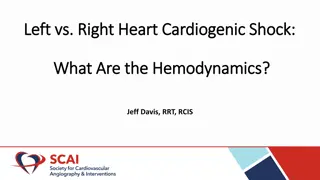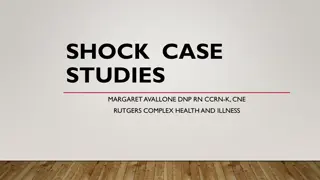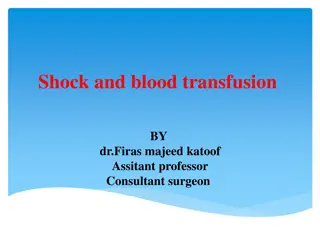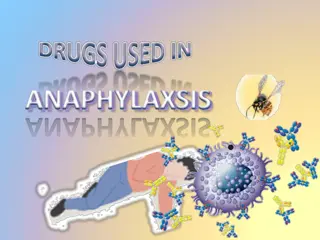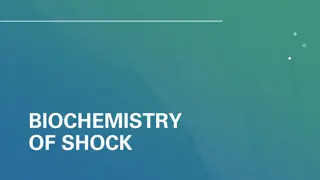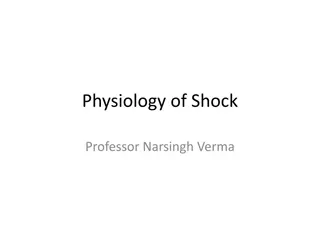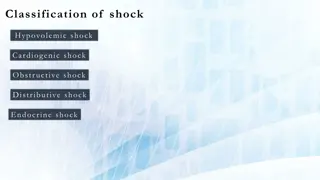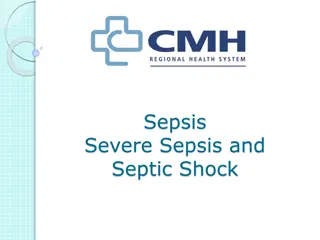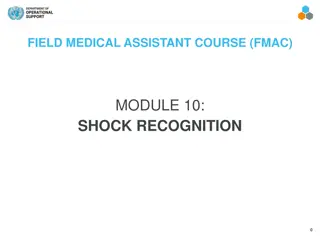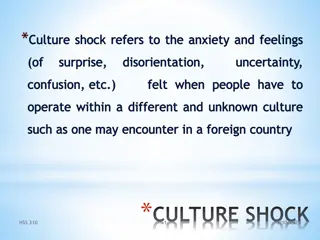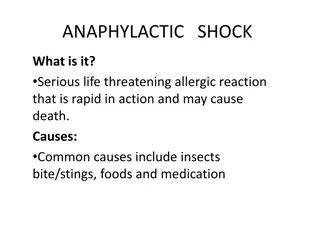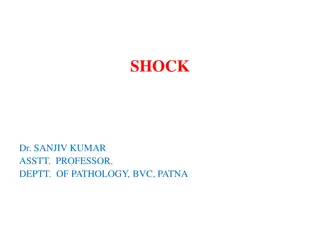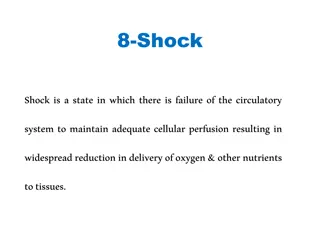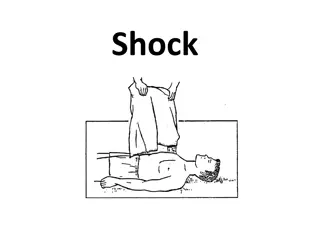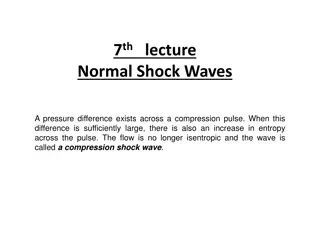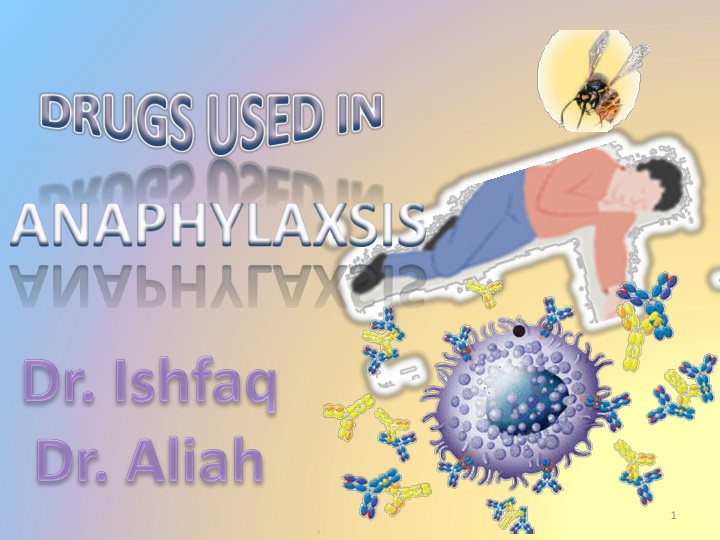
Anaphylactic Shock: Symptoms, Causes, and Management
Learn about anaphylactic shock, a life-threatening allergic reaction that can lead to shock and airway swelling. Discover its symptoms, causes, diagnostic features, emergency management protocol, and different drugs used to limit its outcomes. Understand the nature of shock, including hypoperfusion and various types of shock such as hypovolemic, cardiogenic, obstructive, and distributive shocks. Explore the differences between anaphylactic shock and other types of shock, and identify the mechanism of action and administration of drugs to manage anaphylactic shock effectively.
Download Presentation

Please find below an Image/Link to download the presentation.
The content on the website is provided AS IS for your information and personal use only. It may not be sold, licensed, or shared on other websites without obtaining consent from the author. If you encounter any issues during the download, it is possible that the publisher has removed the file from their server.
You are allowed to download the files provided on this website for personal or commercial use, subject to the condition that they are used lawfully. All files are the property of their respective owners.
The content on the website is provided AS IS for your information and personal use only. It may not be sold, licensed, or shared on other websites without obtaining consent from the author.
E N D
Presentation Transcript
http://t2.gstatic.com/images?q=tbn:ANd9GcRLpdVHcIw3sUPWD5jEtjyA22IgxrsXlY1ug_rFbN_U8fWErnZYB_XZ99Ihttp://t2.gstatic.com/images?q=tbn:ANd9GcRLpdVHcIw3sUPWD5jEtjyA22IgxrsXlY1ug_rFbN_U8fWErnZYB_XZ99I DRUGS USED IN ANAPHYLAXSIS 1
http://t2.gstatic.com/images?q=tbn:ANd9GcRLpdVHcIw3sUPWD5jEtjyA22IgxrsXlY1ug_rFbN_U8fWErnZYB_XZ99Ihttp://t2.gstatic.com/images?q=tbn:ANd9GcRLpdVHcIw3sUPWD5jEtjyA22IgxrsXlY1ug_rFbN_U8fWErnZYB_XZ99I DRUGS USED IN ANAPHYLAXSIS http://t2.gstatic.com/images?q=tbn:ANd9GcRLpdVHcIw3sUPWD5jEtjyA22IgxrsXlY1ug_rFbN_U8fWErnZYB_XZ99I By the end of this lecture you will be able to: Perceive the differences between anaphylactic shock & other types of shock Recognize its nature, causes & characteristics Specify its diagnostic features Identify its standard emergency management protocol Justify the mechanism of action & method of administration of each of the different used drugs to limit its morbid outcomes. 2
ANAPHYLAXSIS Is a sudden, severe allergic reaction affecting the whole body symptoms including: Rash Mucosal swelling Difficulty breathing Reduced blood pressure SHOCK What TYPE of shock is it ??? ANAPHYLACTIC SHOCK A life-threatening allergic reaction that causes shock (hypoperfusion) and airway swelling. 3
SHOCKGeneralized circulatory derangement causing multiple organ HYPOPERFUSION [Inadequate oxygen delivery to meet metabolic demands] & strong sympathetic activation when intense or sustained enough, irreversible derangements sets permanent functional deficit or death Hypovolemic Haemorrhage / fluid loss (plasma, ECF) Cardiogenic Inability to contract & pump myocardial infarction Obstructive Extracardiac obstruction Pul. embolism, cardiac tamponade Distributive PR septic shock, neurogenic, anaphylactic shock. Severe, life-threatening, generalized or systemic hypersensitivity reaction in response to allergen. 4
http://t2.gstatic.com/images?q=tbn:ANd9GcRLpdVHcIw3sUPWD5jEtjyA22IgxrsXlY1ug_rFbN_U8fWErnZYB_XZ99Ihttp://t2.gstatic.com/images?q=tbn:ANd9GcRLpdVHcIw3sUPWD5jEtjyA22IgxrsXlY1ug_rFbN_U8fWErnZYB_XZ99I ANAPHYLACTIC SHOCK Belong to TYPE I HYPERSENSITIVITY REACTION Nature Occurs after exposure to foreign substances [antigen ]; food, insect or animal venom, drugs, blood products, .. IN PREVIOUSLY SENSITIZED PERSONS (antigen-specific IgE are present) What happens ??? Mast Cell N.B. Non-Immunologic Anaphylaxis (ANAPHYLACTOID) Exogenous substances directly degranulate mast cells Radiocontrast dye, Opiates, Depolarizing drugs, Dextrans 5
Second or later exposure ANAPHYLACTIC SHOCK Mast Cell DEGRANULATION Characters Antigen Re-exposure http://t2.gstatic.com/images?q=tbn:ANd9GcRLpdVHcIw3sUPWD5jEtjyA22IgxrsXlY1ug_rFbN_U8fWErnZYB_XZ99I Histamine, Leukotrienes, others 2. Mucous Swelling Rhinitis 16% Angioedema 88% Airway 56% GIT 30% 4. 1. Circulatory Collapse Hypo-perfusion 47% 3. 88% 33% Shortness of breath Rapidly developing [ 5/30 min. can be hours ] Severe, life-threatening Multisystem involvement Mortality: due to respiratory (70%) or cardiovascular (25%). 6
http://t2.gstatic.com/images?q=tbn:ANd9GcRLpdVHcIw3sUPWD5jEtjyA22IgxrsXlY1ug_rFbN_U8fWErnZYB_XZ99Ihttp://t2.gstatic.com/images?q=tbn:ANd9GcRLpdVHcIw3sUPWD5jEtjyA22IgxrsXlY1ug_rFbN_U8fWErnZYB_XZ99I Fainting, Syncope ANAPHYLACTIC SHOCK IS A MEDICAL EMERGENCY WHERE IMMEDIATE TREATMENT IS NEEDED TO PREVENT POTENTIAL DEATH. 7
ANAPHYLACTIC SHOCK Open Airway O2 Inhalation Respiratory Support DIAGNOSIS IS MADE Circulatory Support Lay down / Legs up Fluid Replacement http://t3.gstatic.com/images?q=tbn:ANd9GcS7EucNp21yE0ppnBTZElCEn_ZFV73b_riNTvgoJN1uB-VYz41Pi22pT7AI Adrenaline IM by Auto-injector Or by syringe 8
ANAPHYLACTIC SHOCK THERAPY PROTOCOL 6. Bronchodilators 7. Glucagon 8. H2 Blockers 9
ANAPHYLACTIC SHOCK THERAPY PROTOCOL To support the respiratory & circulatory deficits To halt the existing hyper-reaction To prevent further hyper-reaction of immune system Objective of Therapy Biphasic phenomenon 2nd release of mediators without re-exposure to antigen (in up to 20% ) Clinically evident 3-4 h after the initial manifestations clear. 10
A Sympathomimetic. A nonselective AD agonist [ 1, 2, 1, 2 ] Mechanism Actions As an -AD agonist Reverses peripheral vasodilation maintains BP & directs blood flow to major organs edema reverse hives, swelling around face & lips & angioedema in nasopharynex & larynx As a -AD agonist Dilates bronchial airways + cells 2 effect force of myocardial contraction effect Contraindications Rare in a setting of anaphylaxsis Not given > 40 y cardiac patient ADRs Dysrrhythmias histamine & leukotriene release from mast PHYSIOLOGICAL ANTAGONIST Attenuates the severity of IgE- mediated allergic reactions. Indication DRUG OF CHOICE 11
Administration Best is (IM) route in anaphylaxis. Why ? Easily accessible Greater margin of safety no dysrrhythmias as with IV No need to wait for IV line if present given by physician under monitoring Repeat every 5-10 min as needed Patients observed for 4-6 hours. Why ? Fear of biphasic anaphylaxis Auto-injectors Kits; Disposable, prefilled devices automatically administer a single dose of epinephrine in emergency N.B. Caution Patients taking -blockers either are Refractory; as it may antagonize effects of adrenaline Rebound hypertension [unopposed effect], specially when adrenaline is repeated If hypotension persist start dopamine. Why not noradrenaline? 12
It can not be used alone not life saving Given slowly IV or IM Reverse hypotension & bronchoconstriction mediators (anti-chemotactic & mast cell stabilizing effects) Also decrease mucosal swelling and skin reaction release of inflammatory This is through immediate GCs action on Membrane-bound receptors modulating levels of 2nd messengers (within seconds or minutes) Non-genomic action (genomic action is slow may take hrs - days) May help to limit biphasic reactions allergic mediators. 13
It can not be used alone not life saving Given slowly IV or IM (e.g phenaramine) Though mast cells have already de-granulated, yet these drugs can still help to counteract histamine-mediated vasodilatation & bronchoconstriction May help to limit biphasic reactions by blocking histamine receptors The significance of H2 blockers is not established, these drugs are associated with serious adverse drug interactions. Proton pump inhibitor (e.g. Pantoprazole) is safer and given once. 14
ANAPHYLACTIC SHOCK THERAPY PROTOCOL Bronchodilators : Salbutamol nebulizer / Ipratropium nebulizer / Aminophylline IV Glucagon: For patients taking -blockers & with refractory hypotension 1 mg IV q 5 minutes until hypotension resolves H2 blocker: Ranitidine 150 mg IV / No cimetidine in elderly, renal/ hepatic failure, or if on -blockers.?? 15
Inhalational Salbutamol 2-AD agonist short acting, rapid relief onset relax bronchial smooth muscle & may decrease mediators release from mast cells & basophils It may also inhibit airway microvascular leakage Ipratropium Anticholinergic longer duration of action Less rapid in action secretion Parentral AminophyllineIV may be useful in the treatment of anaphylaxis when inhaled broncho-dilators are not effective & bronchospasm is persistent Given in hospital setting as levels of drug should be Therapeutically Monitored (has narrow therapeutic index). 16
Drug of choice for severe anaphylaxis in patients taking -blockers Has both positive inotropic & chronotropic effects on heart cardiac cyclic AMP an effect entirely independent of adrenergic receptors, that is why effective in spite of -adrenergic blockade. Efficacy of acting on bronchi < heart no evident bronchodilation. Glucagon Gs Gs M2& M3 Sympathomimetics Ipratropium 17


